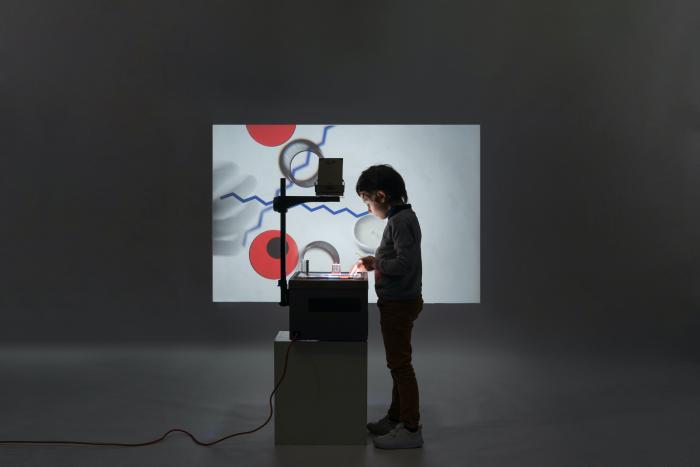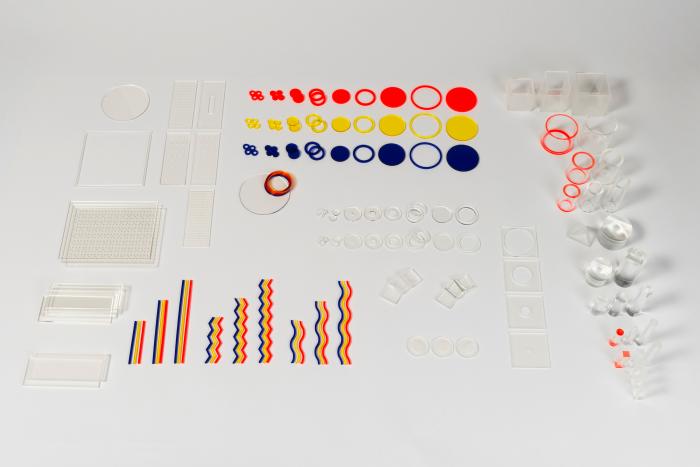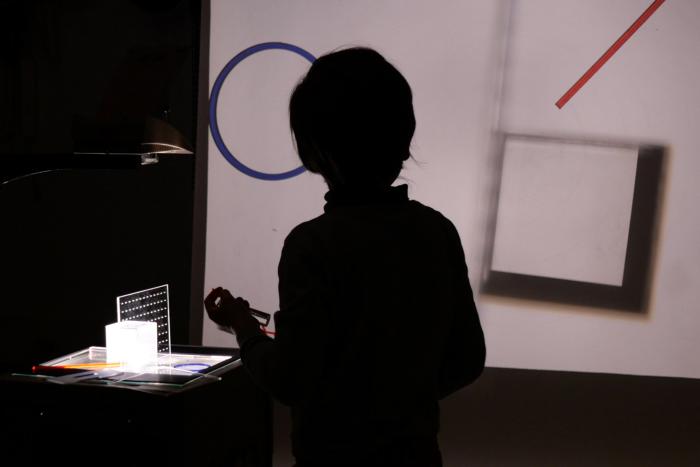I. SUMMARY INFORMATION
Project
269753
Status
Submitted
Award category
Reinvented places to meet and share
You want to submit
NEW EUROPEAN BAUHAUS RISING STARS : concepts or ideas submitted by young talents (aged 30 or less)
Project title
Hands Down
Full concept/idea title
Hands Down, museums, children, Art interaction & active contemplation
Description
Hands Down is a lightning inclusive museum tool inviting children to compose and play with rear-projected components on the surface of an overhead projector, in response to the surrounding art pieces.
By contemplating her projected interaction on the museum’s walls, the child can conquer not only her relation to the artworks, but also to the museum space itself.
A project supporting children inclusivity in museums and early art education, highlighting wonder and imagination.
Where is your concept/idea being developed or intended to be implemented in the EU?
France
Paris
67 Avenue des Gobelins
Paris
75013
II. DESCRIPTION OF THE PROJECT
Please provide a summary of your concept/ idea
Hands Down is an inclusive, interactive and contemplative museum tool for children to discover, understand, appreciate and explore modern art.
Engaged in museum spaces and placed among the artworks, Hands Down is a game of creation and manipulation taking place on the surface of an overhead projector.
Addressing the fundamental needs of children's arts education and cultural spaces inclusivity, Hands Down offers young visitors an interface to invest in the discovery and exploration of their contemplative skills.
The game offers a two dimensions interplay, from interaction to observation. By combining a 3D creation space and a 2D projection surface, Hands Down invites both to create and contemplate. The child is challenged to consider the close relationship between his interaction, volumic, tangible, dynamic, and the result of this interaction, to be witnessed as a work of art, static and essential.
Hands Down offers a stationary overhead projection surface, accessible in museum spaces, enhanced by playful rear-projectable components to be manipulated on it.
Hands Down features several sets of game pieces, each designed to recall a particular Art movement. Each collection provides the fundamentals of an Art movement, to be enhanced by contemplating the actual works. It is the first step to the discovery of a movement, made interactive by the manipulation of the pieces supporting it.
The first set of pieces is based on the Bauhaus movement, whose pieces recall the colors, shapes, aesthetics but also the methods and philosophy: the collection combines flat components, inviting to a surfacic composition, and volumic components, allowing games of balance and accumulation, recalling the architectural works of the movement and exploiting the optical properties of the projector.
It is an inclusive, sensitive and creative tool of art education, aiming to empower children to discover and contemplate artworks with their own tools.
Please give information about the key objectives of your concept/idea in terms of sustainability and how these would be met
Hands Down shares the UNDP statement “that education is one of the most powerful and proven vehicles for sustainable development.”
When it comes to children's Art Education, activities are often reduced to creative plastic experiments, rarely linked to the encounter of real artworks. Hands Down helps children to reach cultural and artistic literacy through an autonomous activity, following Sugatra Mitra’s belief that “children can teach themselves” speaking about his Hole in the Wall project.
What is true for technical education is also true for cultural and artistic education. On one hand, the game will have a short-term impact on the child, inviting him/her while having fun to develop his/her capacities of expression and imagination, but also of observation and abstraction.
On other hand, the game proposes a long-term impact, more fundamental, starting the development of the artistic sensitivity of the child, engaging in the long term his familiarity and the quality of his perception of the art works.
This game will represent a first initiation and discovery of the art world, while preserving a sensitive (and not theoretical) interaction with the works of art.
Moreover, such an education in art facilitates the approach to other disciplines: sense of abstraction, manipulation of concepts, discovery of new environments and languages, development of autonomy,...
Hands Down creates an effective learning environment for all within an existing institution dedicated to the diffusion and promotion of art. Thanks to its mobility, it can also be used in remote private or public places such as schools.
Finally, Hands Down is technically simple, can be built locally with recycled or recyclable materials, and is energy efficient. Basic versions can be easily built from existing and disused overhead projectors.
Please give information about the key objectives of your concept/idea in terms of aesthetics and quality of experience beyond functionality and how these would be met
Hands Down's strongest statement comes from the choice to use light projection as the result of interaction, providing two dimensions to a game that can therefore be just as introspective as it upholds a shared experience.
The projection is thus the aspect of the project that is the less functional and interactive, as rather intangible and contemplative. This aspect allows to project a creative process that may usually remain secret and momentary, offering a unique aesthetic of intimacy, uncertainty, imperfection and randomness.
This new kind of precarious aesthetic fits into the blend of artworks surrounding it, creating a new category of objects playing with the perception of images, in contrast to the traditional criteria of steady and consistent exhibitions regular aspect.
Through its lighting dimension, the intervention also blends with the architecture of the space, playing with aspects of depth and texture that also depend on the surrounding environment, or even the shadows of the other visitors crossing the spotlight.
Its generative dimension also involves games of scale and depth, made possible by the subtle transition between the small and the large, the volumic and the surface.
The final aesthetic aspect comes down to the child's game, subject to many symbols and made visible without limits of possibilities, giving rise to an infinite number of interpretations.
Hands Down, with only a few pieces, gives rise to thousands of visual possibilities depending on who invests it, and thus contributes to redefine the space and atmosphere of the museum at each passage.
Each individual intervention gives the place, its public and its artworks an infinite generation of visual interventions, lively, uncertain and tumultuous.
Please give information about the key objectives of your concept/idea in terms of inclusion and how these would be been met
Because it will be directly implemented in the museum space, Hands Down allows contemplation and interaction to be involved in the museum journey, rather generally associated with a passive and cerebral experience.
The integration of a simple device seeking to facilitate the encounter with artworks enables the inclusion of more different types of audience in museum spaces, and thus in the main access to Art.
According to Jo Birch, museum geographer, this inaccessibility is unfortunate for children, but also for adults. Museums are one of the few spaces where children and adults share equal status. They share the same role of "experimenter" and "novice", supposed to discover artworks through the body and the senses. Traditionally, adults are assigned the role of cerebral observer, without the tactile and sensory aspect that is usually reserved to children.
Hands Down takes the risk of including children in museums unconditionally, with their specific baggage of active and restless observers, in reaction to numerous initiatives of children activities implanted since a long time in museums, but in rooms annexed to the exhibition space, undoubtedly for fear of disrupting the established passive and calm order of the exhibitions.
Consequently, the project proposes not only to support but also to highlight the very particular process of discovery and observation of children, taking the stand that anyone in the museum space can be inspired and stimulated by it.
Therefore, children are not only included in the process, but highlighted and valued for their unique contemplative and communication skills.
Finally, the whole process of interaction and reaction around the intervention creates an interpersonal and even intergenerational museum experience, strengthening social cohesion, and implementing a shared sense of ownership and co-creation of the space.
Please explain the innovative character of your concept/ idea
According to many listings of activities for children in museums, very few integrate them directly within the exhibition space itself.
When they do, very few give children the opportunity of a contemplative experience, beyond entertainment.
As a result, most children's activities relating to art accessibility succeed in combining long-term impact to educational quality.
While the majority of children love these initiatives, very few will benefit from this experience in their future relationship to the world of art and culture.
Consequently, Hands Down strives to achieve two impacts at the end of the experience.
The short-term impact lies in the playful development of their abilities for expression, imagination, observation and abstraction.
The long-term impact, more fundamental, involves the development of the child's artistic sensibility, engaging in the long term his knowledge and the quality of his perception of the artworks.
This game will provide an early introduction to the art world, while preserving a sensible (and not theoretical) interaction with the artworks.
Children will develop an attachment to the image encountered, as it was presented to them through the form of a game engaging their sensitive abilities.
Furthermore, Hands Down focuses on bringing children in touch with abstract and non-figurative artworks, in opposition to the almost systematic preference of figurative pieces in art education programs.
Although often associated with figuration, children are sometimes best suited to appreciate and contemplate abstraction, due to their quasi total freedom from aesthetic or cultural bias.
Hands Down allows them the opportunity to experience the very essence of the pictorial work, of shapes, colors and textures, accessing a more fundamental contemplation, free of connotations.
Please detail the plans you have for the further development, promotion and/or implementation of your concept/idea, with a particular attention to the initiatives to be taken before May 2022
1: Team building - Bringing together a pluridisciplinary team, consisting of a museum institution open to alternative and inclusive experiences, children's professionals, and exhibition curators to structure the itinerary between the artworks on display and the implemented devices.
This step is intended to establish a concrete plan for the potential implementation of Hands Down on site, as well as to work on the children experience.
2: In situ Testing - The already functional prototype has been tested with a 5 years old child as part of a partnership with Beaubourg Museum, providing a proof of concept outside the museum. Next step would be to test the prototype in museums, with the aim to gather field in situ observations, among with feedbacks from visitors and testers.
3: Product design and specifications - From prototype to Minimal Valuable Product:
- Covering functional needs, ergonomics and technical issues defined in the previous phase;
- Facing legal safety and security constraints with special attention to the use by children, and sustainability of materials and processes;
- Investigating whether refurbished or recycled overhead projectors are usable, to increase the sustainability of the project.
4: Design of projectable elements - Designing a new collection in collaboration with other artists and designers, to provide a creative interface, aiming at bringing together aesthetic, sustainability and inclusivity objectives.
Conceiving a customized exhibition in relation to the collection (itself in relation to a relative exhibition), to allow a second test in a completed situation.
5: First production series - If the previous phases are validated, work with Fab Labs to produce small series of projectors and collections of projectable elements. Prepare more exhibitions including feedback protocols and communication campaigns.
→ thus promote the idea and get more coverage for the dissemination of a concept of inclusi
III. UPLOAD PICTURES
IV. VALIDATION
By ticking this box, you declare that all the information provided in this form is factually correct, that the proposed concept/idea has not been proposed for the New European Bauhaus Rising Stars Awards more than once in the same category.
Yes














